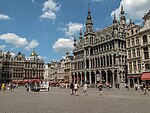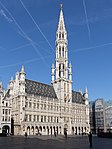Flower Carpet (Brussels)
City of BrusselsCulture in BrusselsHistory of BrusselsSummer events in BelgiumTourist attractions in Brussels ... and 1 more
Use British English from August 2022

The Flower Carpet (French: Tapis de Fleurs, Dutch: Bloementapijt) is a biennial event in Brussels in which volunteers from around Belgium convene at the Grand Place, the historic centre of the city, to weave a carpet-like tapestry out of colourful begonias. The event takes place every other August, coordinating with Assumption Day. Nearly a million flowers are required to create the ephemeral 1,800 m2 (19,000 sq ft) carpet.
Excerpt from the Wikipedia article Flower Carpet (Brussels) (License: CC BY-SA 3.0, Authors, Images).Flower Carpet (Brussels)
Grand Place, City of Brussels Pentagon (Brussels)
Geographical coordinates (GPS) Address Nearby Places Show on map
Geographical coordinates (GPS)
| Latitude | Longitude |
|---|---|
| N 50.846666666667 ° | E 4.3525 ° |
Address
Grand-Place - Grote Markt
Grand Place
1000 City of Brussels, Pentagon (Brussels)
Belgium
Open on Google Maps











